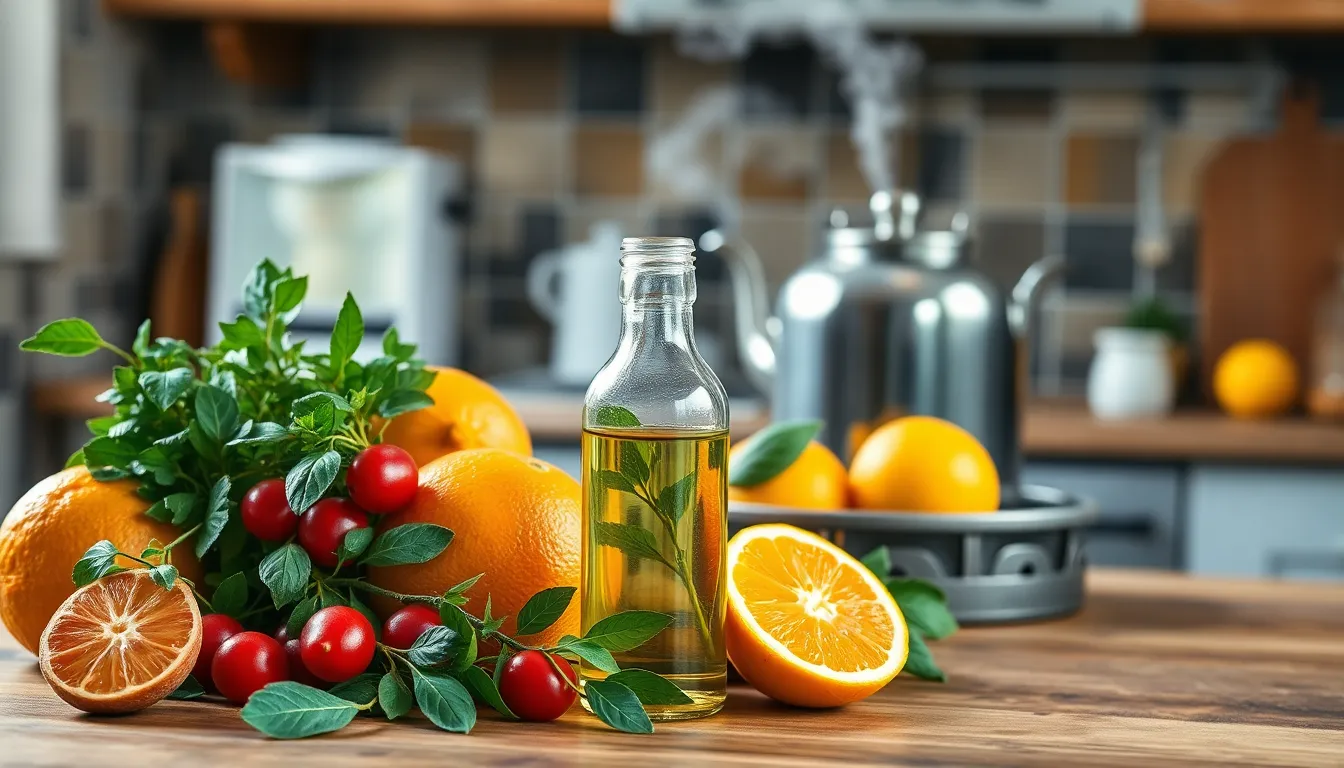Imagine transforming your kitchen into a fragrant oasis where you’re the master of your own aromatic destiny. Making essential oils at home isn’t just a fun weekend project; it’s a chance to unleash your inner apothecary without breaking the bank. Why settle for store-bought oils filled with mystery ingredients when you can craft pure, natural oils that smell so good they might just convince your cat to stop ignoring you?
Table of Contents
ToggleUnderstanding Essential Oils
Essential oils are concentrated plant extracts, capturing the aromatic compounds of various plants. These oils showcase the natural essence of the plant, offering numerous applications.
What Are Essential Oils?
Essential oils encompass volatile compounds extracted from plants through methods like steam distillation or cold pressing. They contain the characteristics that provide fragrance and therapeutic properties. Citrus fruits produce oils like lemon and orange, while herbs such as lavender or peppermint offer distinct scents and benefits. They can be used in aromatherapy, perfumes, and household products, functioning as natural alternatives to synthetic chemicals.
Benefits of Essential Oils
Benefits of essential oils include therapeutic and emotional support. They possess anti-inflammatory properties that may aid in reducing pain and managing stress. People often use essential oils for improving sleep quality, boosting mood, or enhancing overall well-being. Certain oils, like tea tree or eucalyptus, serve as natural antiseptics, providing health benefits without harsh chemicals. These oils also promote relaxation when diffused or added to baths, creating a spa-like experience at home.
Methods for Making Essential Oils

Making essential oils at home involves various methods. Each method has unique advantages and processes.
Steam Distillation
Steam distillation extracts essential oils by passing steam through plant material. During this process, steam vaporizes the volatile compounds, which then cool and condense into liquid. The result consists of essential oil and hydrosol. Steam distillation works effectively for most plant materials, including herbs and flowers. This method maintains the therapeutic properties and aromas of the plants, making it the most popular technique for high-quality essential oils.
Cold Press Extraction
Cold press extraction primarily applies to citrus fruits. This technique involves mechanically pressing the peels to release the oils within, avoiding heat. The result is a pure essential oil with vibrant fragrances. Since no heat is involved, the delicate compounds remain intact, preserving the natural scent and properties. Essential oils extracted through cold pressing are often more fragrant and refreshing, appealing to many users seeking citrus notes.
Solvent Extraction
Solvent extraction employs chemical solvents to retrieve essential oils, particularly from delicate flowers. This method dissolves plant materials, separating the oils from the solids. Afterward, the solvent evaporates, leaving behind a concentrated oil. Solvent-extracted oils can capture more complex aromas and compounds. However, some residual solvents may remain, leading to potential purity concerns. While this method produces rich fragrances, those using it should ensure the final product maintains safety and quality standards.
Ingredients and Equipment Needed
Making essential oils at home requires specific ingredients and tools for effective extraction. Understanding what to gather is key to a successful process.
Common Plant Materials
Lavender buds serve as a popular choice for creating calming essential oils. Peppermint leaves provide a refreshing aroma along with invigorating properties. Eucalyptus leaves are known for their medicinal qualities, perfect for respiratory support. Citrus peels, especially from oranges and lemons, yield bright, uplifting fragrances. Rosemary needles offer an earthy scent that promotes mental clarity. These plant materials capture flavors and scents best when sourced fresh, ensuring high-quality oils.
Essential Tools for Home Extraction
A heavy pot or saucepan allows for effective steam distillation when combined with a heat source. A fine mesh strainer helps separate plant material from extracted oils, ensuring purity. Glass containers with lids store finished oils and maintain freshness. Cheesecloth is essential for filtering delicate extracts, particularly in cold press methods. Essential oil bottles prevent light exposure, preserving the oils’ properties over time. Measuring cups and spoons assist in maintaining accurate ingredient ratios throughout the process.
Step-by-Step Guide to Making Essential Oils
Making essential oils involves precise techniques and high-quality ingredients. The following steps walk through the essential processes.
Preparing Plant Materials
Gather fresh plant materials for optimal results. Use lavender buds for calming oils, peppermint leaves for refreshing aromas, and eucalyptus leaves for respiratory support. Ensure the plants are free from pesticides or chemicals. Rinse the materials gently under cold water to remove dirt. Chop or bruise the plant materials to increase surface area, making extraction more efficient. Measure the ingredients accurately to maintain consistent ratios during the distillation process.
Distillation Process
Begin the distillation process by filling a heavy pot with water. Add plant materials to the water and place a lid upside down on the pot, allowing steam to condense and drip back down. Heat the pot gradually to produce steam without boiling the water. Collect the condensed steam in a glass container positioned under the lid’s center. Monitor the extraction for 30 to 90 minutes, as this duration varies based on the type of plant used. Capture the essential oil floating on top of the water after distillation completes.
Bottling and Storing Essential Oils
Transfer the extracted essential oil into a clean, dark glass container. Dark glass protects oils from light, preserving their integrity. Use a funnel or dropper for clean transfer without spilling. Label each bottle with the oil type and extraction date to maintain organization. Store the containers in a cool, dark place to enhance shelf life. Properly bottled and stored essential oils can last from one to several years, depending on the plant’s characteristics and extraction method employed.
Safety Precautions
Essential oil production requires careful handling and storage to ensure safety and effectiveness. Prioritizing safety practices protects both the user and the therapeutic qualities of the oils.
Handling Essential Oils
When handling essential oils, using gloves is recommended to prevent skin irritation. Avoid direct contact with sensitive skin areas. If accidental exposure occurs, rinse the affected area with plenty of water. Always keep essential oils away from the eyes; flushing with water is crucial if contact happens. Proper ventilation while working with oils prevents overwhelming scents and enhances comfort. Store oils safely out of reach of children and pets. Properly labeling all containers aids in easy identification. Knowing that some essential oils may cause allergic reactions emphasizes the need for patch testing before widespread use.
Storage Tips
Storing essential oils properly enhances their longevity. Use dark glass containers to protect oils from light, preserving their quality. Keep oils in a cool, dry place to avoid heat degradation. Noting expiration dates on labels helps track oil freshness. Avoid placing essential oils in bathrooms, where humidity can negatively impact them. Store oils upright to prevent leaks and spills. Grouping similar oils together simplifies organization and retrieval. Regularly check for signs of degradation, such as discoloration or changes in scent, to determine usability.
Making essential oils at home is a rewarding venture that combines creativity with wellness. By choosing to create these oils from fresh plant materials, individuals can enjoy the purity and potency that commercial products often lack. The methods outlined provide flexibility for anyone looking to explore the world of essential oils.
With proper techniques and tools, anyone can produce high-quality oils that enhance their daily lives. The therapeutic benefits of these oils can support emotional well-being and overall health. Embracing this DIY approach not only fosters a deeper connection to nature but also empowers individuals to craft their own aromatic experiences.




